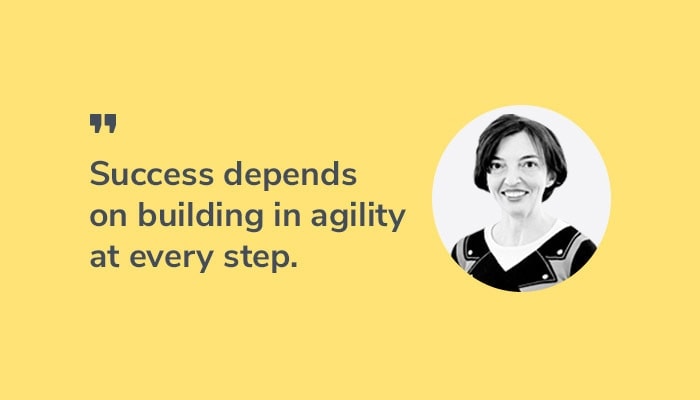The secret to improving business outcomes? Move Fast!

Business leaders today are under constant pressure to react quickly to the market and ever-changing customer needs. Success ultimately depends on their ability to build in agility at every step, from strategy to execution.
What Is Agile?
Think about Agile as a flexible approach to managing projects that uses frequent iterations to test and learn, enabling responsiveness to change. As a term, Agile refers to a specific set of roles, methods and tactics (e.g. scrum master, pod team structure) and centers on sequences of short work cycles, used to produce prototypes for testing. Project plans and goals within this framework are not set in stone. Rather, they evolve as the environment and customer needs change.
According to Gartner Research, the majority of the organizations surveyed use Agile Methodology at varying degrees of maturity. It makes sense, as different organizational structures and frameworks would work for different companies. As long as they are aligned on the outcomes they are working to drive, they can use elements of an agile working environment to accelerate their path to success.
Talent Considerations
For an approach like this to succeed, organizations need to assemble a team of people who can thrive in an environment that prioritizes agility. When evaluating talent, the ability to learn should carry significant weight alongside the prerequisite skills and experience for a given role. With the right people in place, business leaders should then empower the team with ongoing development and learning opportunities, as well as the tools, technology and data they need to succeed.
Organizational Structure
Another critical element of achieving organizational agility is a seemingly simple consideration: where do you maintain insights that enable agility? Three of the main organizational structures for insights distribution are centralized, decentralized, and hybrid:
- Centralized ensures a coherent experience across all team members, as well as shared methodology, measurement and governance. On the flip side, this structure can be rigid, time-intensive, and present a risk of misalignment of the output to the goals of different functions.
- Decentralized enables flexibility and speed, but can present a lack of consistency in methodologies and measurements. Additionally, there can be a lack of efficiency, especially when the same problem is tackled separately by multiple teams.
- Hybrid attempts to maintain the respective positives while balancing out negatives of the prior two structures; but could mean a higher cost to the organization (as a larger team is needed and a greater share of the budget goes towards analytic talent and tools).
Whatever your overarching goals are for achieving organizational agility, make sure you measure how you are achieving them, and evaluate how a given structure enables you to deliver on these goals.
To schedule time with an industry expert for tailored guidance and an action plan that meets your objectives, visit our Meet The Experts page to learn more.





